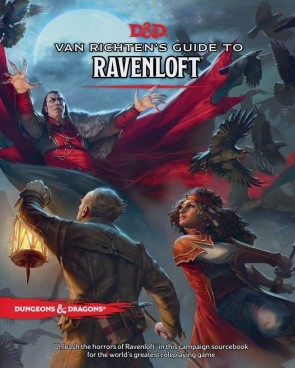Too much horror busines.
Ravenloft is one of the crowning glories of Dungeons & Dragons. The first edition I6 module is one of the best TTRPG supplements ever written, a stunningly evocative adventure that takes a hard left from the standard Appendix N-influenced fantasy that was the defacto D&D setting back in 1983, veering into Gothic territory complete with all the Hammer trappings. Barovia is a land benighted by shrouds of mist, creepy creatures, forlorn castles, and of course an inimitable and tragic vampire – the great Count Strahd von Zarovich. Ravenloft was updated five years ago for 5E in the Curse of Strahd book and despite some culturally insensitive depictions of the Romany-influenced Vistani people, it was mostly a great refresh and a fine example of the best that the current edition has to offer. Now, Wizards is offering up another book to expand the Ravenloft concept and Van Richten’s Guide to Ravenloft has emerged from the Domains of Dread.
Interestingly, it’s as much a DM’s guide for horror-based adventures as it is anything to do with Ravenloft proper. There is abundant guidance for playing with various types of horror, including a sort of guide to various genre mutations that explains differences between Cosmic Horror, Slasher Horror, Disaster Horror, Folk Horror, Body Horror, and so forth. There are numerous suggestions for maintaining a safe table, respecting boundaries, understanding the difference between scaring players and scaring characters, and managing expectations. These are important considerations when dealing with horror subject matter that can run the intensity gamut from Scooby-Doo to Cannibal Holocaust. Advisement is provided to help DMs work out how to create fear, suspense, and terror in their games and although a lot of it is likely familiar for the seasoned, it’s all a great baseline resource for creating horror-based games.
Central to many players’ interest will likely be a few new character options including the sure-to-be-popular Dhampir, horror backgrounds, a cool new Bard College (Spirits), and of course a new Warlock- an undead one. There are also some fun Dark Gifts, in case you need rules for a Symbiotic Being or a character that has a death touch. All pretty much expected stuff, but then there is one piece that I found surprising. There’s a small suite of rules to create and run “Survivors”, more thinly fleshed-out characters with limited specs that are suitable for one-shots or for situations where, for example, players might find themselves playing other characters from a memory or in a nightmare.
I found this notable given D&D’s current emphasis on super-heroic, idealized selves with extensive backstories. And here is an official sanction for the DM to go for the jugular and kill off disposable PCs (with consent and within the parameters of established expectations, of course). To my mind, this is essential for the horror in any of the stories this book wants to tell- there simply must be a fear of death or else the practically unkillable 9th level Warlock winds up being a more monstrous threat than Strahd. Back in the B/X days, characters were more fragile and players tended to be less invested at a personal and emotional level in them, so even a simple dungeon crawl could feel dangerous and high stakes. Survivors return at least some of that to D&D, even if only in a marginal way that I suspect many players will ignore anyway.
As far as setting and fixed D&D story material goes, there is an absolute wealth of content here with a treasure trove of Domains of Dread described in a kind of gazetteer. These are all demiplanes, each imprisoning and tormenting one or more Darklords and each with a unique atmosphere, themes, or concepts for your party to explore. There’s a lot of inspirational material here, even if you don’t choose to use the proprietary lore. They cover a wide range of horror styles – one is a full-on zombie apocalypse, there is a Southeast Asian influenced Domain, another is focused on Frankensteinian mad science. Possibly my favorite is the haunted lightning rail train from Eberron. There’s also a mummy one, which is going to be the one I run for a summer campaign with my kids. If you have something else in mind, there are rules to make a bespoke Darklord and a Domain in which to imprison them.
There’s a small bestiary of new monsters and they are mostly pretty good but nowhere near as horrifying or weird as what you’ll find in something like Fire on the Velvet Horizon or any given Mork Borg book. NPCs, including several iconic Ravenloft characters from the setting’s long history, are described so longtime fans will love to see familiar faces like Jander Sunstar or the Weathermay-Foxgrove Twins. The Vistani return, but this time with the harmful and ugly stereotypes mostly expelled. It’s all very toolbox-y, with plenty of room left for the DM to work with in terms of weaving these raw materials together across these characters, Domains, Darklords, and genres.
Frankly material of this sort is handled more effectively and efficiently in any number of other indie games. But this is a 5E book, the Big Show. The audience for this book is 50 million people, not 500 Kickstarter backers. Of course it does feel somewhat like D&D is playing catch-up to the small press scene with some of the material and content that might seem forward-thinking and innovative for a Hasbro-controlled IP, and of course it doesn’t come across as particularly maverick or exciting if you are out here running Witchburner with Best Left Buried or whatever. But it is also making these kinds of stories and concepts more accessible and approachable for a more mainstream audience that expects D&D to be about dungeons and dragons and not much more. So this is a good thing, expanding the horizons of the game for a broad audience. The indie books are there for those looking for the deeper, more nuanced, and more sophisticated dive.
What I’m left with above all in regard to Van Richten’s Guide to Ravenloft is that it especially works as an inspirational tool and if I were less familiar with horror concepts and roleplaying ideas, I’d be especially impressed with the quality and quantity of information presented here. But it is not a new “adventure path” or Tomb of Annihilation-style storyline. There is a pretty decent short adventure included, but using this book most effectively is going to require some DM work whether it is for a one-shot, Secrets of Saltmarsh style haunted house romp or an expansive campaign involving multiple sites and encounters in one of the Domains of Dread. So it’s not a great book for those who want it to be a sequel to Curse of Strahd. But with that said, this is a far better and more useful volume than WotC’s big, sprawling, over-written campaign books.
I’m also left with another thought. This format practically demands to be used to introduce a more science fiction-centered setting into 5E. And by that, of course, I mean Spelljammer.
 Games
Games How to resolve AdBlock issue?
How to resolve AdBlock issue? 









